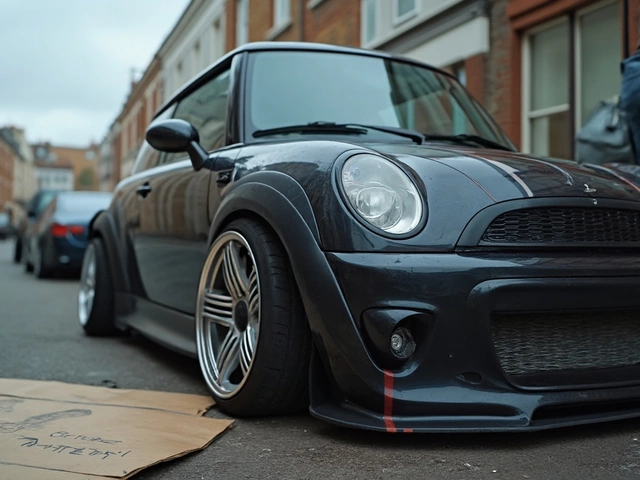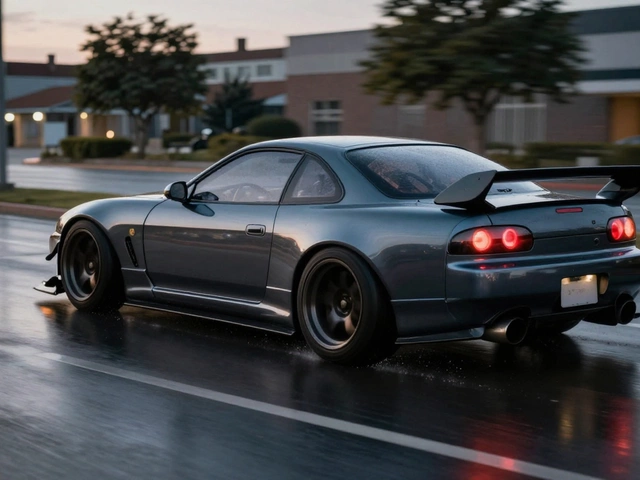Think lowering your car is all about making it look meaner? That’s just the start. Choosing between coilovers and lowering springs can totally change how your ride feels every day, not just the way it sits.
Coilovers give you loads of adjustment—height, damping, maybe even stiffness. Lowering springs? They drop your car, usually a fixed amount, and don’t mess with much else. Seems simple, right? But there’s a lot hiding under the surface that can seriously affect how your car handles, how comfy it is on city streets, and even how much cash you’ll cough up in the end.
If you’re planning to mod your suspension, you’ll want the real pros and cons spelled out without the hype. Let’s break down what actually changes when you bolt on coilovers versus just swapping in springs, and how to decide what’s right for your style and your wallet.
- How Coilovers Actually Work
- What Lowering Springs Really Change
- Price Differences: Are Coilovers Worth It?
- Handling and Ride Comfort Compared
- Installation Hassles: DIY or Shop?
- What to Pick for Daily Driving or Track
How Coilovers Actually Work
Coilovers are basically your all-in-one setup for dialing in exactly how your car sits and handles. Instead of just swapping out springs, you’re replacing both the spring and shock together with a single, adjustable package. This is the biggest reason people choose coilovers—control. You get to pick the height, and on better kits, you can tweak the stiffness (damping) too.
When pros talk about coilovers, they usually focus on these key points:
- They let you change ride height in small steps, not just what the factory gives you.
- Most sets let you adjust damping, so you can choose softer for cruising or stiffer for handling.
- They boost the look—goodbye wheel gap, hello mean stance.
- On higher-end kits, you can also adjust spring preload and even camber, which is huge for track use or tight wheel fitment.
This is what sets coilovers apart—they don’t just lower the car, they let you fine-tune the whole suspension feel. A typical off-the-shelf kit can let you drop your car from stock height down to as much as 2-3 inches lower, sometimes more if you want to go wild.
| Feature | Coilovers |
|---|---|
| Height Adjustment | Yes (Wide Range) |
| Damping Adjustment | Usually Yes (Depends on Model) |
| Preload Adjustment | High-End Kits Only |
| Camber Plates | Some Kits |
Good coilovers aren’t just for track junkies, either. Plenty of daily drivers use basic kits for improved looks and a firmer feel. But here’s the deal: ride comfort can get stiffer, especially if you aim for that slammed look. There’s a sweet spot, and you’ll need to play around with settings to find it.
As car handling expert Mike Kojima puts it,
"Coilovers offer the most flexible way to dial in your suspension, but they take some tinkering to get them perfect for regular driving."
If you care about tweaking height, handling, and style—and don’t mind more complexity—coilovers might be your move. But keep reading, because springs have their own strong points too.
What Lowering Springs Really Change
So, what actually happens when you stick a set of lowering springs on your car? First up—the most obvious thing is your ride sits lower. This gives you a sportier look and, for a lot of people, that’s the main reason to do it. But the real effects go deeper than just looks.
Lowering springs swap out your stock springs for stiffer, shorter ones. This usually drops your car by about 1–2 inches, depending on the kit. By changing the spring height and rate, your car’s whole stance and handling can shift.
Here’s what changes after you bolt on lowering springs:
- Suspension travel is reduced: Which means there’s less ‘bounce’ over bumps.
- Center of gravity drops: Helps the car feel a bit more planted in corners.
- Body roll is reduced: Stiffer springs = less leaning in bends.
- Looks way sleeker: No more wheel gap staring at you.
- Tire wear can become uneven: If your car’s alignment isn’t checked after install, you might burn through tires fast.
- Ride comfort changes: The ride usually gets firmer, sometimes much firmer.
"Most drivers notice a tighter, more connected feel after installing lowering springs, but they need to be aware that ride quality can suffer if paired with stock shocks." – Car and Driver Suspension Guide
Still, the ride feels different for everyone, and it depends on the rest of your setup. If you reuse your stock shocks and they aren’t built for stiff springs, they can wear out quicker. Some people swap both springs and shocks, or go straight to a coilover setup, to avoid this problem.
Want the hard numbers? Here’s a quick comparison between stock springs and lowering springs:
| Stock Springs | Lowering Springs | |
|---|---|---|
| Average Drop (inches) | 0 | 1–2 |
| Spring Rate (lb/in) | 100–150 | 200–300 |
| Stock Shock Life | Full lifespan | Often reduced if not upgraded |
| Ride Quality | Softer, more comfort | Firmer, less comfort |
No matter what, good alignment is a must after lowering your car. Neglecting this step is the quickest way to regret your new look when you shell out for new tires.
Price Differences: Are Coilovers Worth It?
Let’s talk numbers because price is often the dealbreaker. Good lowering springs usually run between $150 to $400 for a set. Even top brands rarely crack $500. That’s it for the parts. Most folks with a jack and some patience can swap them in on a Saturday too, saving shop labor.
Now look at coilovers. A decent entry-level set starts around $600, and it’s easy to find options over $1,000 (think KW V1, Tein Flex Z, or BC Racing). Want premium or custom-valved coilovers? You’ll push into the $2000+ range. And because coilovers offer more adjustments, setup can get complicated, so labor costs at a shop often double what a simple spring swap runs.
Ask yourself: do you really need all those adjustments? Most daily drivers just want a better stance and a firmer feel—not a track-tuned setup. For street cars, springs do the job for way less cash. But if you want to slam your ride low, raise it again for winter, or tweak your damping to match your style, coilovers give you freedom—at a price.
- If you’re on a tight budget and just want your car lower: Springs win.
- If you love tweaking your ride’s feel and height, or you plan to track your car: Coilovers are worth considering.
- Factor in install costs—a shop might charge $200 for springs, but $400 or more for coilovers with alignment.
Bottom line: coilovers offer more, but you pay for it, both up front and whenever you need tuning or servicing. Be honest about your goals and don’t let internet hype empty your wallet.

Handling and Ride Comfort Compared
This is where coilovers and lowering springs really show their differences. Let’s get straight to it. When it comes to handling, coilovers almost always take the trophy. Most coilover setups let you dial in your ride height and usually stiffness, meaning you can tweak things for a weekend track blast or soften them for daily commutes. Some high-end kits even have 30 or more rebound and compression settings. Lowering springs, on the other hand, tend to be a one-size-fits-all deal—installed once and that’s that. Your car sits lower, maybe feels firmer, but you don’t get adjustment.
Handling gets sharper when you drop the center of gravity. Both options do this, but coilovers give you more control over how low you want to go and let you corner flatter with better grip. If you’re just aiming for a cleaner look and a slight improvement, lowering springs do the job. If you want to carve through corners and adjust for different roads or tracks, coilovers are the play.
But here’s the flip side: ride comfort. Lowering springs usually keep things close to stock comfort, unless you slam the car too low or pair them with cheap shocks. Most people barely notice a real difference on city streets unless the roads are really rough. Coilovers, especially budget sets, can get harsh real quick. You’ll feel more bumps, and sometimes potholes or cracks make the car jump. Quality kits and softer adjustments help, but don’t expect luxury-level comfort without spending more.
If you want a quick look at how both compare, check out this table. On a scale of 1 (worst) to 5 (best):
| Upgrade Type | Handling Improvement | Ride Comfort | Adjustment Options |
|---|---|---|---|
| Coilovers | 5 | 2-4 (varies) | 5 |
| Lowering Springs | 3 | 4 | 1 |
Bottom line: for pure customization and sharp handling, coilovers win. For a mild drop without killing comfort, lowering springs are hard to beat.
Installation Hassles: DIY or Shop?
So you’ve picked your suspension upgrade—but now you’ve got to actually get those parts on your car. The real question: should you do it yourself, or pay a shop?
Swapping in lowering springs is usually pretty straightforward, especially if you’re handy with a wrench and have spring compressors. For many cars, you can do this in your driveway with basic tools like jack stands and sockets. Still, you need to know that dealing with compressed springs isn’t a joke—if one pops loose, it can seriously hurt you. Not feeling that risk? Better let a pro handle it.
Coilover installs are a step up in terms of time and tools. Most coilover kits are bolt-on, replacing your whole shock and spring setup. That can save time versus fiddling with springs alone, but you’ll still need to take apart lots of suspension parts and might have to deal with rusty bolts or stubborn bushings. Plus, after the install, you’ll need an alignment—new ride height will mess with toe and camber settings. Some shops even offer corner balancing, which really brings out the best in coilovers if you’re into spirited driving or track days.
“Never forget to get an alignment after messing with your suspension at all. Doesn’t matter if it’s just springs or full coilovers—you want your tires to last and your car to drive straight.” — Chris Fix, YouTube automotive DIY expert
If you’re doing this at home, set aside at least a full afternoon, maybe more if it’s your first time. It can get frustrating, especially with older cars where bolts are seized or bushings won’t budge. Shops often charge a few hundred bucks for installing either springs or coilovers, depending on your car. The extra for coilovers is mostly about set-up time and fine-tuning ride height if you want it just right.
- DIY install saves money but takes time and patience—plus basic mechanical skills.
- Shops have the right gear and can align your setup right after.
- Either way, always factor in the cost of an alignment post-install.
If you’re only lowering your daily and don’t care about fine-tuning, springs might be a quicker and easier option. But if you’re after maximum adjustability and a dialed-in suspension, coilovers plus pro help are worth it—even if your wallet groans.
What to Pick for Daily Driving or Track
This is where your choice gets real. Are you using your car every day to work or school, or are you spending weekends at the track pushing it hard? Your answer decides a lot.
If daily driving is your main thing, lowering springs are usually the smarter move. They’re cheaper, easier to install, and you won’t notice a huge change in comfort—unless you go crazy low, then even potholes might ruin your day. Most lowering springs drop cars 1-2 inches, still keeping things practical for everyday speed bumps and parking lot ramps. Companies like Eibach and H&R are known for making sets that ride almost like stock, just a bit firmer and lower.
If you split time between highways and back roads, a spring and shock combo might be your sweet spot. Upgraded shocks with lowering springs help control that bounce so you don’t end up hopping like a lowrider over rough roads.
But if track days call your name, coilovers are worth it. Serious coilovers give you way more adjustment. You can stiffen things up for cornering on the track, and sometimes dial it back for the ride home. Want your car slammed for style or raised for rough surfaces? Coilovers do it all—no need to keep swapping parts every time your needs change.
- Daily Driving: Go with lowering springs for affordability, comfort, and simplicity.
- Weekend Track: Coilovers deliver the performance and tuning options you need, especially if you’re aiming for best lap times or serious handling upgrades.
- Do-it-all Build: Some high-end coilovers handle daily commutes without turning your spine to dust, just don’t expect $300 kits to do it all well.
Let’s break it down with some quick stats:
| Lowering Springs | Coilovers | |
|---|---|---|
| Cost (avg) | $250-$400 | $700-$2000+ |
| Ease of Install | Easy-Moderate | Moderate-Hard |
| Height Adjustability | No | Yes |
| Comfort (stock-like) | Mostly yes | Depends on model |
| Best For | Daily, Street | Track, Customization |
Pick based on what you actually do with your car, not just how you want it to look. For most daily drivers, springs keep things simple and cheap. For serious handling or custom stance, coilovers are king—but your back and your wallet might pay for it.




